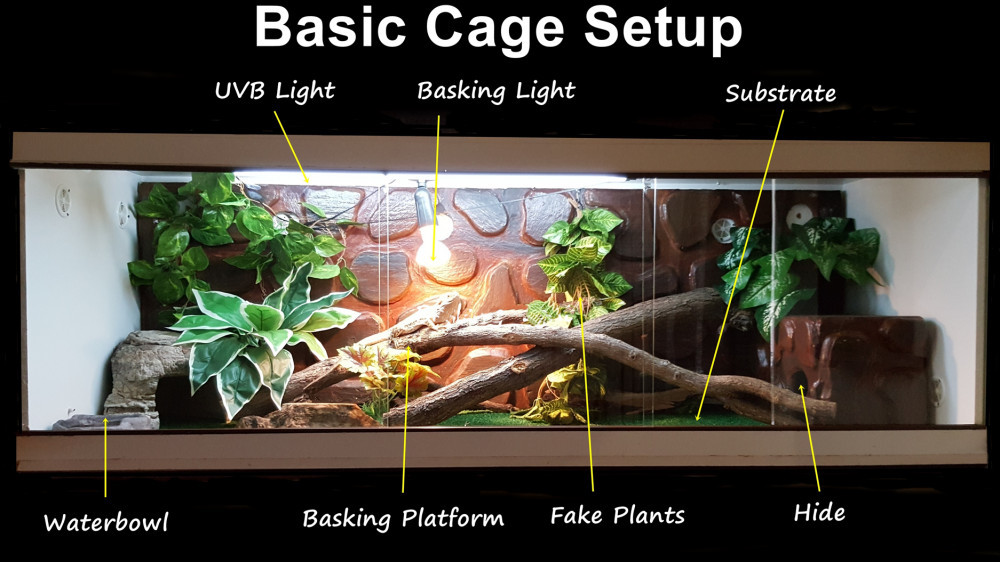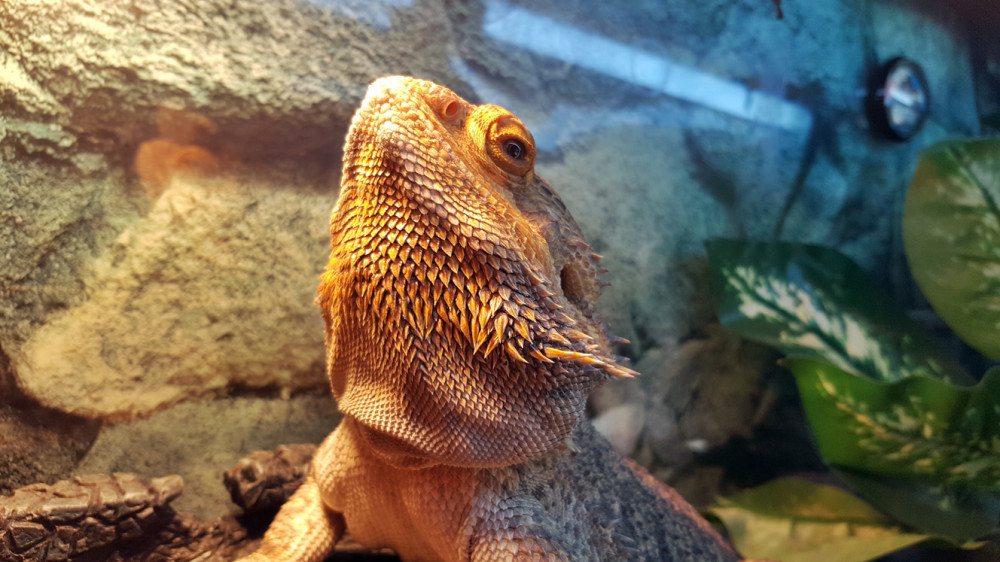Bearded Dragons come from the Australian deserts and must have full-spectrum lighting for up to 12 hours a day. They will need both a UVB light and a heat source to keep them healthy.
The UVB light will replicate the sun’s UVB and provide them with the vitamins that they would normally generate from natural sunlight. A heat lamp will replicate the heat that they need to thrive.
Without the proper lights, your dragon will get sick!
Bearded dragons depend on UVB and heat to stay alive and healthy, without the proper lights, serious illnesses like metabolic bone disease can occur. MBD cannot be cured and it is one of the most horrible sicknesses a beardie can face. UVB will help your dragon to absorb calcium and have a good bone structure, without it, the bones will turn to jelly and bent.
Additional symptoms from not having a UVB light and heat are lack of appetite, lethargy, and terrible stunting of development.
Bearded Dragon Lighting Setup
UVB Light
UVB lighting is necessary for your Bearded Dragon to synthesize vitamin D3. Vitamin D3, in turn, is needed to absorb calcium.
Bearded dragons have high UVB requirements and cannot stay healthy on a low amount of UVB like many other lizards, thus an output of 10.0 is required.
Switch the lights off at night so your bearded dragon can sleep peacefully.
There are currently a wide variety of UVB lights available on the market and this can easily cause confusion. I only recommend what is tested to work the best; let’s have a look at the options:
Fluorescent/Linear Tubes
The Fluorescent/Linear Tubes deliver a proper UVB output. Whenever you combine this with a UVA basking light or household light you will acquire better UVA lighting than either produced alone. Fluorescent UVB lights consume a big part of the tank and thus the UVB is equally distributed. Linear tubes must be placed more or less 6 inches from your pet. They are appropriate for whatever size of the tank since they come in different lengths. They need to be replaced once every 8 months or so, depending on the brand. The appropriate one is the Repti Glo 10.0 or Reptisun 10.0 (most beneficial)
There are two fixtures that can be used when tubes are in play. You can either use a Ballester, but make sure that the watt-itch is the same as that of the light. Or you can use a batten fitting, but again make sure that the watt output is the same as that of the light. If the watt output is higher than the lights, you will blow the light and they do not come cheap. If it is too low, your dragon will not get the UVB that is necessary to stay healthy.

Compact/Coils
Coils can also be used, but be very careful which brand you use and so forth. When using a coil, I recommend Exo-terra or Zoo-med brands. The coil will also need to be a 10.0 output and needs to be placed in the area where your dragon spends most of his/her time, the basking spot for instance. The reason for this is that the coil only covers the area where it is placed and not the entire tank. Using multiple coils to cover the entire tank is not recommended, because it will be a wire overload and fire hazard. The coils use the ordinary light fitting, the same as the basking lights.
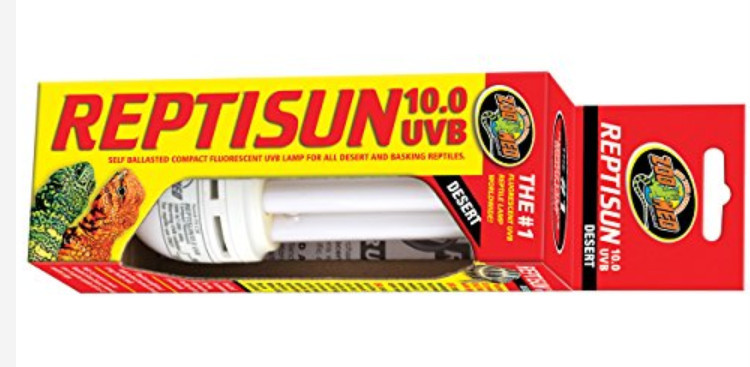
A Basking Light/Bulb
Bearded dragons are cold-blooded and gather heat from the sun to warm up their body temperatures. Without a proper heat source, you will end up with a sick beardie!
A heat lamp will increase the temperature in your terrarium. Heat is essential for digesting food and the activity of your reptile. You will find many types of heating, lights, and basking lights, these vary from 25 W all the way up to 150 W. Bigger cages will require stronger heating lamps while standard ones will need nothing more than 50 – 75 W. It is always a good idea to read the instructions on the packaging before you purchase your lamp. In addition, you also want to compare your environment with the type of light that you plan to install. If you live in a country with a warm climate, you will not need a lamp with a high output. For cold climates, it is recommended to invest in a 75 -150 W heating lamp or basking light.
Temperatures should be monitored at all times. Burning is a real danger and you do not want your beloved animal to suffer from burns or overheating. Be sure to have an accurate thermostat in your cage to monitor the temperatures!
Almost all bearded dragon light bulbs and so forth use screw-in light fittings.
Again, there is a wide variety of heating lamps and special bulbs, making it hard to choose the correct ones. Let us have a look at the ones that work best.
White Basking Spot Light
This is a basking spot lamp that will direct the heat in one direction only. It will not heat up the whole cage, but only one part of the cage so your bearded dragon can bask and enjoy the heat then cool off if he/she wants to. The light will also provide a little UVA (ultraviolet a) for your bearded dragons’ well-being. This is the most favorable heat source.
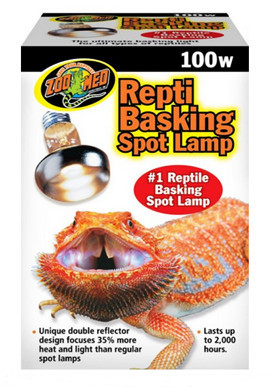
Red Heat Lamp
This is a normal lamp that uses infrared heat waves to heat your bearded dragon’s cage. This light will increase the overall temperature in your cage. The red light does not replicate natural sunlight and it does not give off light, so your bearded dragon will not be able to see too well in his/her cage since they cannot see red light, and that is why it is not recommended as a permanent heat source during the day. On the other hand, the infrared does hold good properties like faster healing time for sick dragons, appetite booster for reluctant eaters, and so forth.
I would recommend if possible, having both lights. The white basking light can be used six days a week with the red light once a week. This way they get the best of both. However, if only one light is an option, it would be the white basking spotlamp during the day.
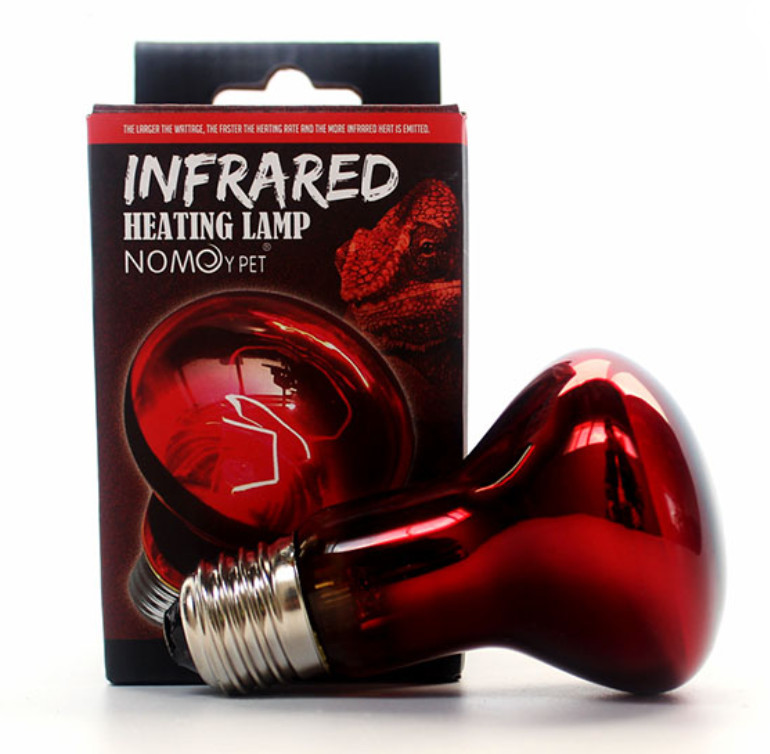
Bearded Dragon Temperature Requirements at Night
Night-time heating is only necessary when the temperature gets less than 70 degrees. The dearest form of nighttime heat for Bearded Dragons is Ceramic Heat Emitters (CHEs). CHEs acquire zero light, only heat. Bearded dragons need darkness to sleep and are kept awake by lights, such as those that acquire a red light or black light, but CHEs do not have any of these troubles. Unfortunately, CHEs are costly, if you cannot buy one of these, the second option would be to use a low-wattage red light. You do not want to raise the temperature too high during nighttime since they need a “cool off” period and they do not need to bask during the night. Ceramic Heat Emitters, nonetheless, work marvelously and are worth saving up for since they last a very long time. Read More About Bearded Dragon Temperature Requirements
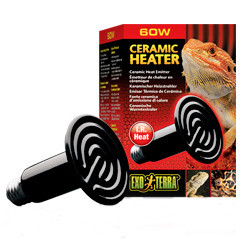
Do Not Use Heat Pads, Cables, or Hot Rocks!
Bearded dragons cannot sense heat on their stomachs and thus can easily burn themselves. In addition, heat pads are not safe, since they can short out and injure your beloved pet. Many such instances were recorded in the past and thus not worth taking a risk.
Bearded dragons need some warmth on their stomachs to help them digest their food properly. It is recommended to place a fake rock or tree stump underneath the basking light instead. The light will heat up the rock/stump and give them enough heat on their stomach. Be sure to have it at the correct distance to avoid it getting too hot or too cold.
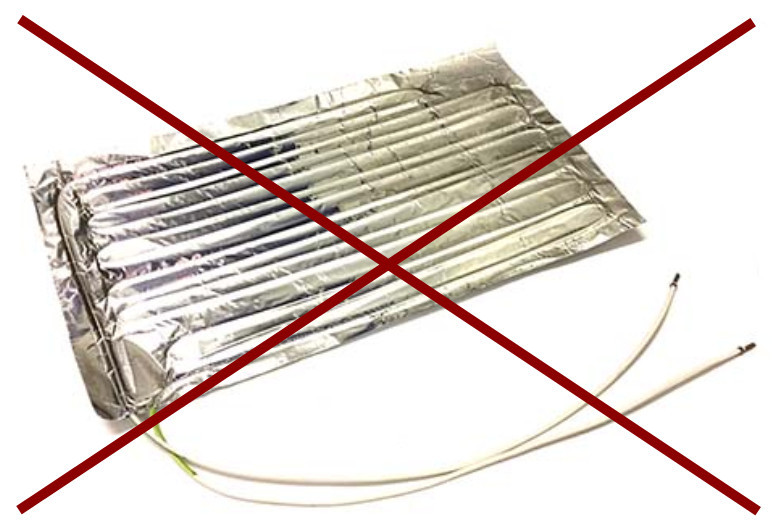
Bearded Dragon Lighting – Other Options
Mercury Vapor Bulbs (MegaRay)
This possesses the ultimate UVB output. They deliver a UVB output corresponding to a sunny area, and your Bearded Dragon runs in and out of it to regulate their UVB exposure. MVB lights should be about a foot away from your Bearded Dragons basking area. The length changes with the particular lamp selected. They’re just appropriate for big tanks, and they need to be replaced yearly. Appropriate ones are the Mega-Ray and Power-Sun.
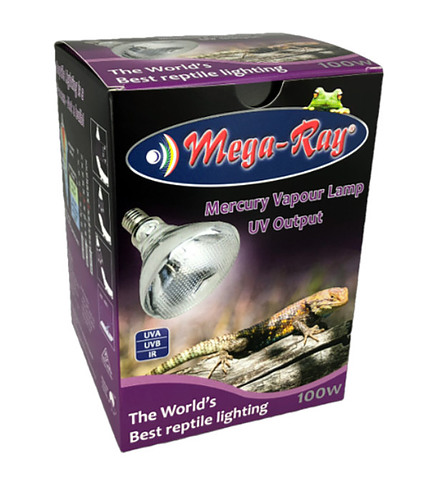
The SunRay/Solar-Glo bulbs
These are all-in-one bulbs that can be used as a sole light source. It combines infrared heat radiation with UVA and UVB. The combination of UVB and heat enables your bearded dragon to produce its own vitamin D3 for calcium absorption and prevents MBD.
The correct fixture must be used with this bulb to make it effective. This is most definitely the best light to have for your beardie, however, it will not work as effectively in a large cage since it will not distribute the light evenly like the tubes. In addition, it acts as a UVB and heat lamp, in many instances, heat lights will be used according to temperatures in the cage. On a hot day, the basking light might heat up the cage too much and thus need to be switched off or be on a temperature timer. In such an instance, your beardie will be left without a UVB light, a bad thing since they need the UVB the entire day.
I would recommend using a SunRay with an additional UVB fluorescent tube. When the cage gets too warm, the tube can be switched on instead.
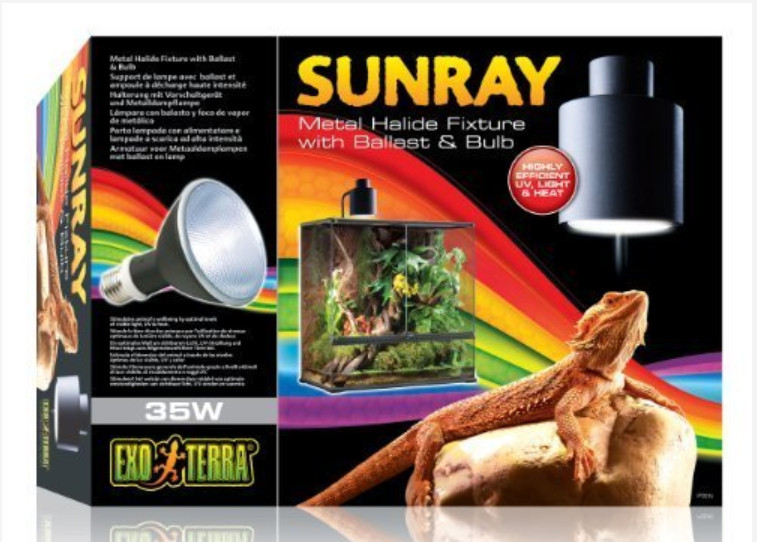
Anion Bulb
I recommend this bulb highly since it improves the air structure greatly in the cage. It removes odor, promotes metabolism, and eliminates dust, toxic gas, and smoke. In addition, it will also increase your beardie’s anti-disease abilities and improve lung and heart function.
Safety First!
Always use porcelain fixtures for your heating bulbs or the fixture that is recommended by the manufacturer. NEVER use plastic fixtures for heating bulbs, they will melt and start a fire.
Another fixture that is worth the investment is the dome setup. The dome setup is literally a dome that can take one or multiple bulbs and is placed on top of the cage. The cage will have to be built in order to support the dome without anything blocking the heat or UV rays coming from the bulbs inside. Domes are very nice to use because they can take more than one bulb, meaning you can either switch between two different bulbs like a red and white one, or you can put a basking lamp along with a UVB coil inside for your beardie to bask under.
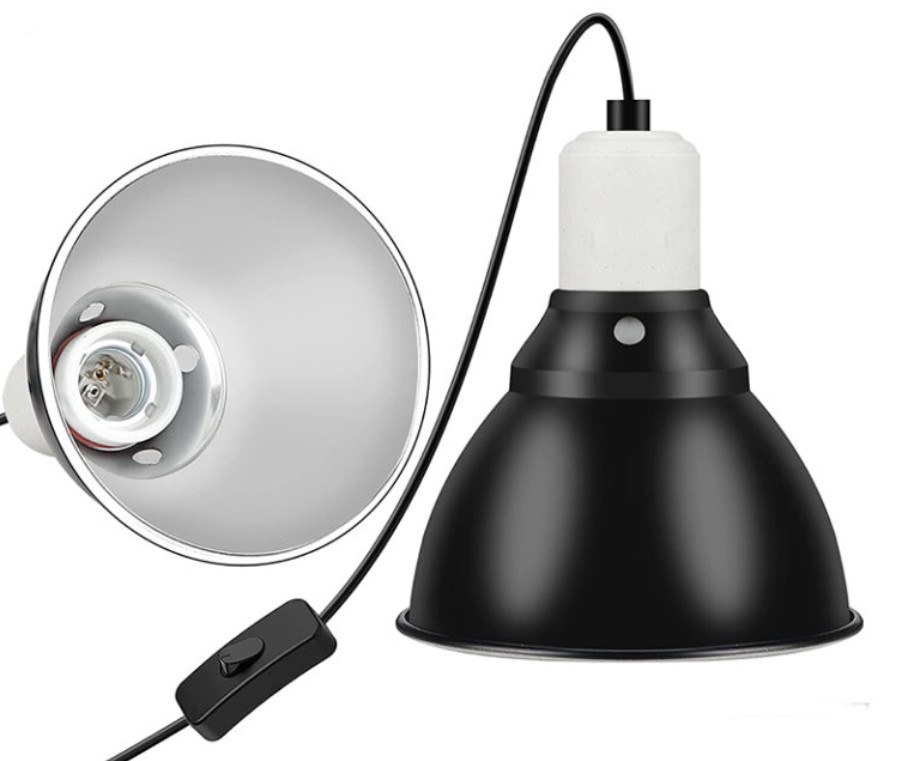
Use proper wiring when you install your fixtures. Remember, the lights will be turned on for hours on end. Low-grade wiring could melt and start a fire.
Be sure that your dragon cannot reach the heat or UVB bulbs. Heat lamps get extremely hot and you do not want to burn your pet or have him break the light and get injured by the glass. Do not underestimate a beardie, they know how to jump! Be sure that there is no loose wiring inside the cage for them to injure themselves or climb on. If one has a mesh screen, the best setup would be using a dome or wire housing like in the picture below.
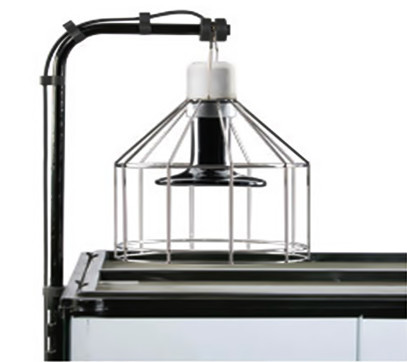
UVB bulbs/tubes should never be placed above a mesh screen; it will affect the UV rays. UVB tubes or bulbs should be attached inside the cage without obstructions.
Be sure that your heat bulb is not too close to the UVB tube. If the tube heats up too much, it could blow out and injure your pet severely.
If your dragon will be left unattended for some time, it is best to invest in a temperature control unit. These units are connected to the heat lamp and will turn it on/off when the temperature gets too hot or cold. In my opinion, this is a must-have if your beardie is left unattended for more than 5 hours at a time. These animals depend on heat, without it they will get sick. However, cooking them in their cage is just cruel and it can happen if temps are not monitored. A temperature control unit will not only keep them happy but also save on your power bill, for the light will switch off when the desired temperature is reached. Remember to switch off at night, if you do not have a ceramic or red light. Dragons need darkness to sleep and a light that switches on and off during the night is sure to keep them awake.
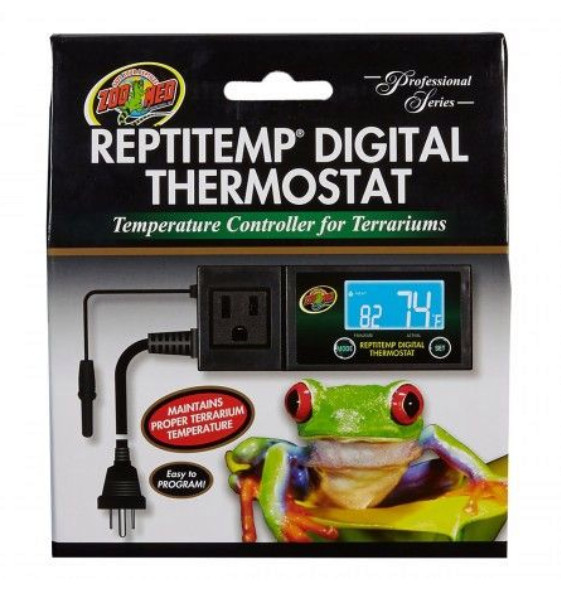
If you cannot invest in a temperature control unit, the second-best option would be to get a plug/switch timer. These will allow you to set the lights to go on and off at certain times. You can program the heat bulbs to go on for 2 hours at a time at half-hour intervals. Again, no light during the night.
Have proper thermostats! Be sure to have a thermostat on the hot and cool side of the cage. Digital thermostats work the best since they are more accurate than analog ones.
Bearded Dragon Lighting and Heating – Tips and Facts
It is a good idea to stick with well-known brands when it comes to reptile lights. The quality of cheap lights can be poor and may not give your bearded dragon what he/she needs. Remember your bearded dragon deserves the best.
You can buy the best UVB light that you can find on the market, but nothing creates UVB better than the sun itself. When it is a sunny day and the temperature is over 80 degrees, take them outside for as long as possible, they will love you forever! Be sure not to let them out of your sight, they can move fast if scared or excited.
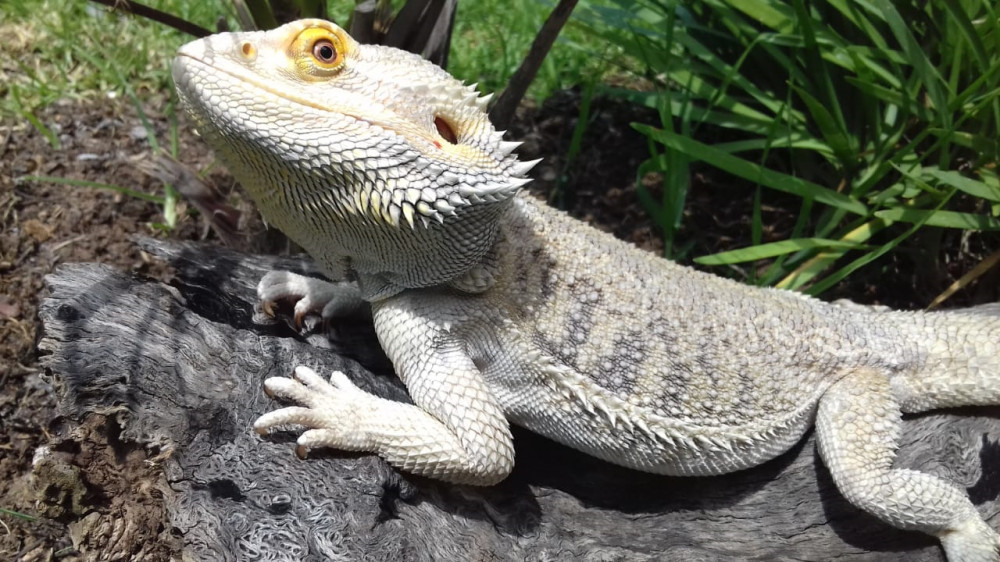
Remember to read the instructions carefully on the manufacturer’s packaging. Each light differs from another and will require different height setups. You do not want to get your dragon burned or deprive him/her of the heat or UVB rays.
UVB rays cannot go through glass or mesh, you will need to put the light in the cage at a distance of 20” /51cm from your bearded dragon basking spot.
Take Note:
Winter and summer temperatures will obviously differ depending on where you live. Our summers are hot, winters are freezing, meaning the same heat bulbs that work well in winter, will heat up the cage way too much in the summertime. I have two sets of heat bulbs, one for summer and one for winter. We have big cages and 50W is more than enough in the hot summer months, sometimes we just switch them off completely because it is too hot. In winter tho, we use 100w to heat up the big cages, and sometimes it gets so cold that we have to add a ceramic heater as well.
When you buy your lights, keep your own climate in mind when doing so. There can not be a “set-in-stone” guidance when it comes to setting up the lights as no house, climate or cage is the same.
Also, keep in mind, that if you go with a big cage (recommended), you will have to up the wattage.
Here is an example of one of my cage setups (Image below)
Huge cage (2m wide)
Summer – 120 cm linear UVB bulb and a 50W heat bulb on a timer during the day. No heat source at night.
Winter – 120 cm linear UVB bulb with a 100W heat bulb during the day and 100W ceramic heater at night.

Have questions about your cage setup?
Please leave a comment below and we will do our best to help.
